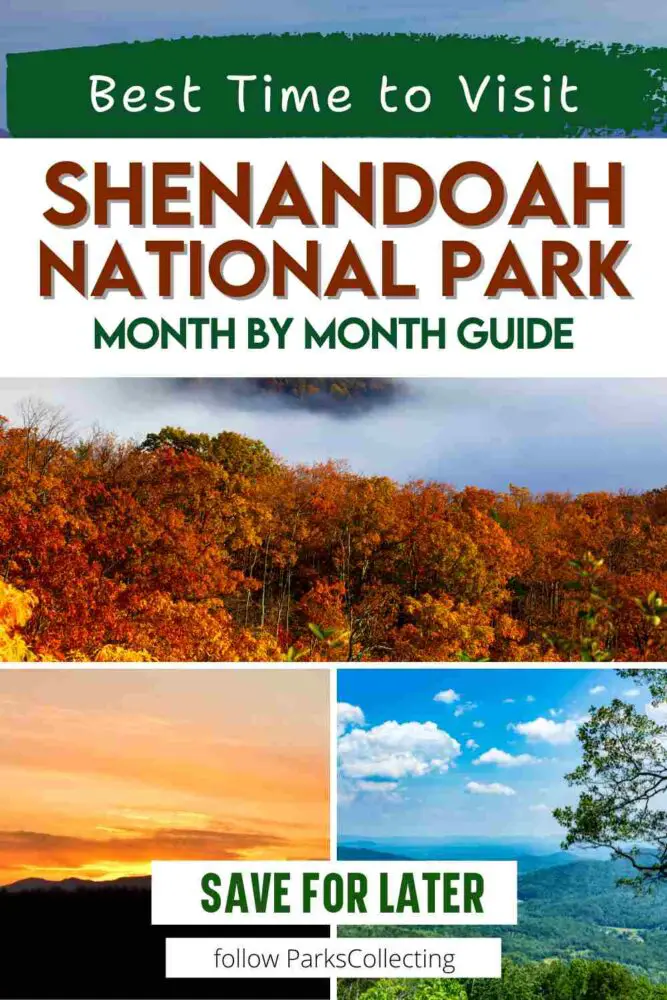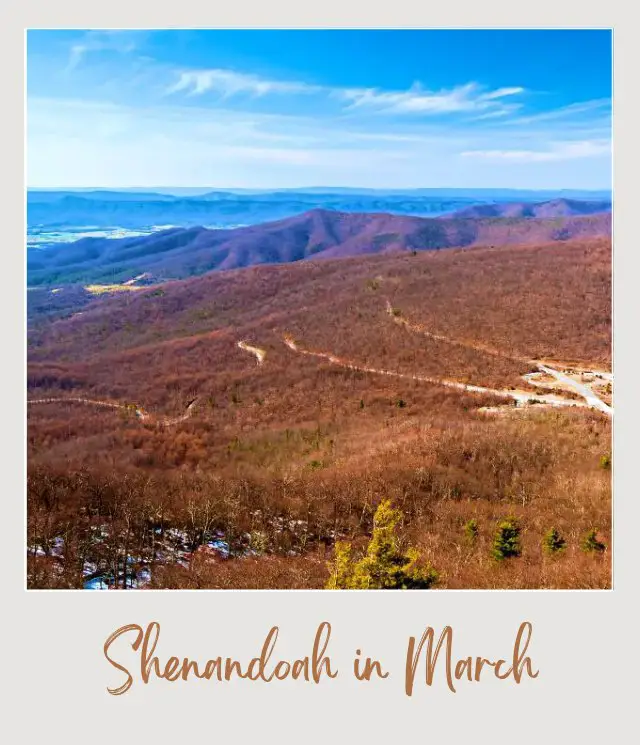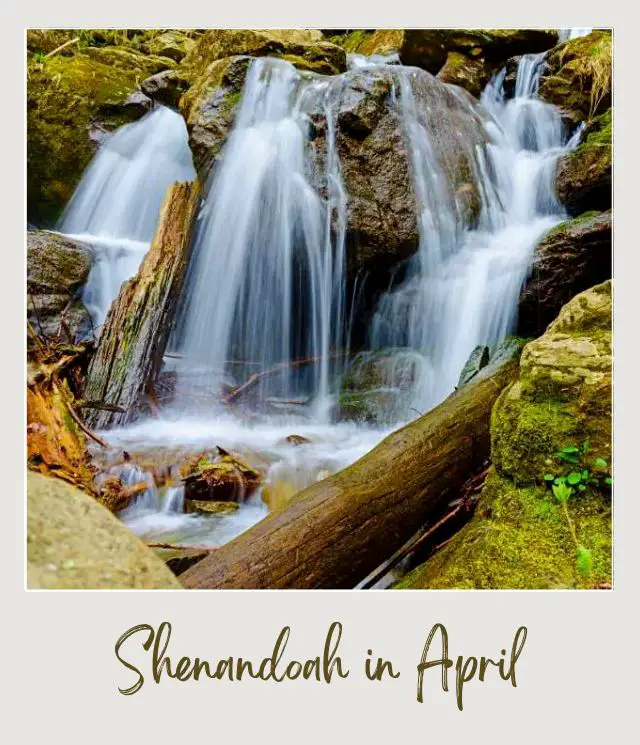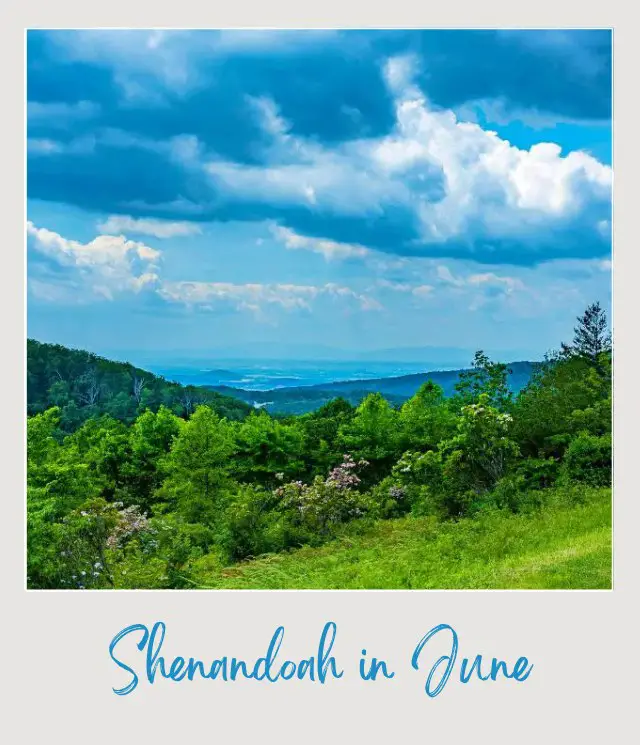Are you thinking about visiting Shenandoah National Park but aren’t sure what to expect when you want to go? Then this guide is for you.
Each of the four seasons gives you a unique picture of the park, so looking for the best time to go depends on the activities you plan to do, your preference for the weather and tolerance of crowds, and the kind of attractions you want to see.
I’m James and I’m a national park expert. In this guide, I’ll take a more detailed look at each season to help you decide on the best time you can visit Shenandoah National Park. I describe the weather in Shenandoah National Park you can expect each month, as well as wildlife, waterfalls, foliage, special events, and more.
‼️ If you just want a quick snapshot of my thoughts on the best time to visit Shenandoah National Park, check out my Best Time to Go to Shenandoah National Park guide. ‼️
Subscribe to daily national parks planning tips, travel inspiration and trip ideas and get instant access to the free PDF of this guide to
Visiting Shenandoah National Park Throughout The Year
No time right now to discover the best time to visit Shenandoah National Park? Pin It and save it for later:


🛏️TOP HOTEL NEAR FRONT ROYAL: Check availability now
🛏️TOP HOTEL NEAR LURAY: Check availability now
🛏️TOP HOTEL IN CHARLOTTESVILLE: Check availability now
🚘FIND THE CHEAPEST CAR RENTAL: Search Discover Cars for the best deals
✈️FIND THE CHEAPEST FLIGHTS: Search Skyscanner for the best deals
🧳GET TRAVEL INSURANCE: Get insured with Travelex before you go
📱TAKE AN AUDIO TOUR: Buy an audio tour now
Table of Contents
Shenandoah National Park – Spring (March – May)

After a long winter season, Shenandoah National Park in spring welcomes visitors with warmer weather from March to May. The fresh green colors are showing up on the trees but the highlights of this season are the beautiful wildflowers and waterfalls.
Wildlife also begins to reappear after months of hibernation and migratory birds heading up north are flocking to Shenandoah.
With most of the facilities and services also opening at this time, it’s also the second-busiest season at the park.
Spring weather varies with occasional showers and snowstorms, especially in early spring, so better save your trip in the later months when the weather is warmer.
Visiting Shenandoah National Park March

What’s it like to visit Shenandoah National Park in March?
It’s still the off-season so the park isn’t crowded yet. However, snow is starting to melt, so the trails are still wet and slippery, which means it’s not the best time to go just yet.
Even though it’s slowly getting warmer at Shenandoah National Park, weather in March will still give you winter storms and snowfalls, which are not uncommon during the early weeks. Temperatures at this time typically range from lows around 35˚F reaching to the mid-50s.
Nevertheless, park trails are accessible and the Big Meadows and the Lewis Mountain campsites are available later in the month. For your supplies, food, and camping needs, the Big Meadows Wayside along with the Lewis Mountain Cabins and Campstore opens later in March.
By the middle of March, the Dickey Ridge Visitor Center and Park Store starts opening from Thursday through Monday.
If you plan to hike to Old Route Mountain, you have to get an Old Rag day-use ticket ahead of time, aside from the park entrance. Tickets are required March 1 – November 30.
➡️ Read More: National Parks That Require Reservations
Pros
- Off-peak so the park isn’t crowded
- Park facilities and services start operating
Cons
- Wet and mucky trails
- Snow, rain, and cold weather still continue
Shenandoah National Park – April

If you’re visiting Shenandoah National Park in April, almost all of the snow has usually melted in the lowlands by this time, with little snow covering the mountains and deeper areas in the forests.
Is it a good time to visit the park? Definitely.
The weather in Shenandoah National Park in April may have unexpected spring showers but you’ll still get to enjoy outdoor activities. Make sure to check the weather forecast and pack extra clothing and gear so you could come prepared for your trip. Shenandoah National Park weather in April has temperatures between 42°F lows and 66°F highs.
The late spring season is the best time to see the colorful wildflowers in full bloom, hike Shenandoah’s popular trails along Old Rag Mountain and White Oak Canyon, and enjoy camping outdoors.
You’ll also enjoy chasing some stunning waterfalls along Skyline Drive and other scenic falls just a few miles hike from there. You don’t want to miss seeing the impressive Overall Run Falls, the highest waterfall in Shenandoah National Park, and the steep route to the famous Dark Hollow Falls with its several stunning cascades.
➡️ Read More: The Best Waterfalls in Shenandoah National Park
Additional food, lodging, and park services opening this month include the Elkwallow Wayside, Skyland, the Loft Mountain Wayside, and Big Meadows Lodge.
Pros
- Beautiful wildflowers views
- Scenic waterfalls
- More park facilities open
Cons
- Unpredictable weather with occasional showers
- Trails are getting crowded
Key Events in (month):
✳️ National Park Week (free day at the park)
✳️ Junior Ranger Day
Visiting Shenandoah National Park in May

May is one of the best times to visit the park if you’re going after the wonderful spring scenery.
Shenandoah National Park weather in May is much warmer as the summer season starts to approach. On a normal day, you’ll experience between a mid-50s low (˚F) to a mid-70s high (˚F).
The park’s popular trails can also get crowded at this time of the year, so make sure to arrive earlier than 8:00 am to avoid the crowds and get parking space. Better yet, you can visit during weekdays or take less famous trails.
➡️ Read More: Best Hikes in Shenandoah National Park
High Top Mountain is one of the less crowded areas in the park which also gives you a great spot to catch the sunset. You can also enjoy lots of bright green spring colors and more waterfall views going to Dolyes Falls.
If you want to go fly fishing, a hike to Bear Church through Graves Mill Trail will lead you to the Rapidan River, one of Virginia’s most beautiful brooks loaded with trout.
The Skyland Stables and Loft Mountain Campstore open up during the month, as well as additional campgrounds in Mathews Arm, Loft Mountain, and Dundo for group camps.
Pros
- Warmer weather
- Waterfall and spring flower views are at their peak
- Abundant wildlife and migratory birds
Cons
- Trails are starting to get crowded
- Limited parking space
Key Events in (month):
✳️ Wildflower Weekend
✳️ Drawing to See (SNPA Seminar)
✳️ Kids to Park Day
Shenandoah National Park – Summer (June – August)

Vacation season also means you’ll expect larger crowds to visit the park. Shenandoah National Park in summer is busy, especially on the weekends.
Shenandoah’s north entrances at Thornton Gap and Front Royal are usually the busiest areas. To avoid the crowds, you can head east on Route 29 through the lowland areas or take either the Swift Run or Rockfish entrance stations via Route 340.
➡️ Read more: Skyline Drive Mile Markers
Also, campgrounds are likely to fill up quickly even if it’s not yet the peak season.
Expect hot and humid weather at Shenandoah National Park, with summer temperatures averaging around the mid-70s (˚F), but its elevation gives enough relief from the temperature on the lowlands.
Visiting Shenandoah National Park in June

Is it good to visit the park in June? Yes.
Summer is still relatively cool in Shenandoah National Park. June temperatures are usually between 84°F to a low of around 62°F. Mountain temperatures are typically 10˚ lower than the valley area.
Since you can expect crowds during this season, it’s best to plan your route and schedule your trip ahead. You can try heading out to less traveled areas around the park or visiting within the week when the crowds are fewer.
➡️ Read More: Best Things to Do In and Around Shenandoah National Park
June offers a distinct display of white mountain laurels blooming in season and hardwood trees showing off their lush green colors. Wildlife is more active this time of the year so there’s plenty of creatures like skunks, chipmunks, squirrels, raccoons, and beavers, as well as black bears and white-tailed deer to spot around Shenandoah.
Pros
- Lots of wildlife to see
- View of lush green forests
Cons
- Busier weekends at the park
- Parking areas easily get full
Key Events in (month):
✳️ National Trails Day
✳️ Go Fishing Day at Big Meadows
✳️ Stroll back in time to a CCC Camp
✳️ The Illustrated Journal (an SNPA Seminar)
Visiting Shenandoah National Park in July

Even though July is considered the hottest month, it’s a popular month to visit Shenandoah National Park. July 4th celebrations are usually the busiest day of the month with visitors flocking to the park for the holiday.
Things warm up at this time in summer Shenandoah Park. Weather temperatures at the park usually rise to an average high of about 87˚F and a low of approximately 65°F. Bringing plenty of water to keep you hydrated and sunscreen to prevent sunburn is essential when you go on long hikes. Ticks are also in season so bug spray is also a must.
Some waterfalls including Overall Run Falls usually dry up in the summer while other waterfalls tend to dry up to a trickle later in the season. But if you still want to enjoy water activities, you can go trout fly fishing at the park streams.
If you’re backpacking on the Appalachian Trail, it’s much better to set your trip for later in July when most of the thru-hikers have already gone farther north by this time.
Pros
- Hiking Trails
- Native trout fishing
Cons
- Hot weather is at its peak
- Some waterfalls dry up
- Plenty of ticks and snakes
Key Events in (month):
✳️ Stony Man Camp
✳️ Painting in the Park Seminar
Visiting Shenandoah National Park – August

Shenandoah National Park in August is still very hot and humid with clear skies on most days. The weather is still perfect to see gorgeous sights at the famous Appalachian Trail, marvel at the majestic Shenandoah Valley vistas, and spot some black bears along the way. Stargazing along the Big Meadows area and Skyland is also one of the most popular activities of the season.
While having these outdoor activities, don’t forget to carry summer essentials like a hat, sunglasses, sunblock, and lots of water. Shenandoah National Park average temperatures during the month go up to the high 80s (°F) with lows around mid-60s (°F), so these can help you beat the heat.
You’ll also come across wildlife along park roads. If you’re driving along Skyline Drive, expect animals like squirrels, bobcats, owls, dear, owls, and turkeys to cross in front of your vehicle. Maintain the 35-kilometer-per-hour speed limit for your safety and enjoy the scenic drive, too.
During the summer months, park services and facilities are usually packed and trails are filled with people, so planning your route and schedule in advance can spare you the hassles.
Pros
- Plenty of trails to hike
- Wildlife viewing and birdwatching season
Cons
- Hot weather
- Crowds flock to the park
Key Events in (month):
✳️ Night Sky Festival
✳️ Anniversary of Great American Outdoors Act
✳️ National Park Service Birthday
Shenandoah National Park – Fall (September-October)

While some prefer to see the park during spring and summer, most people still head out to Shenandoah National Park in the fall. The park is busiest around late September to early-November before the long winter.
If you’re looking for the best time to see fall colors in Shenandoah, the shades of orange, red, and gold are at their peak in the early weeks of October.
Aside from the stunning fall foliage, the weather is also starting to cool down. Since you’ll expect large crowds during fall in Shenandoah National Park, try going to less frequented backcountry areas like the RipRap Trail. You can also get Shenandoah fall color alerts daily through the park’s View from the Valley Webcam.
Visiting Shenandoah National Park – September

What’s it like to visit Shenandoah National Park in September? Fall foliage hues are slowly starting to appear by this time. Since it’s the peak season, the best thing you can do to avoid crowds is to plan your trip on weekdays. Shenandoah has countless trails aside from the more popular ones, so there are plenty of hiking spots you can discover.
Front Royal and Thornton Gap are the busiest entrances and wait times to enter can be long. You can purchase digital entrance passes in advance to save you time.
➡️ Read More: How To Get to Shenandoah National Park
The weather in Shenandoah National Park in September cools down and the average Shenandoah National Park temperature in this month is between 49°F to 60°F during the daytime.
If you plan to go overnight camping, start to expect colder weather at night. Otherwise, you can stay at the park’s historic lodges like Skyland, which offers basic cabins to first-class rooms and suites. Big Meadows Lodge also offers several accommodation options from detached cabins, to conventional rooms and suites.
Hiking to scenic waterfalls is still the fall season’s best Shenandoah experience, along with wildlife viewing in the Big Meadows where deer and bears frequently roam.
Pros
- Hues of the fall season are starting to pop
- Cooler weather starts to set in
- Outdoor activities to enjoy like hiking to waterfalls and viewing wildlife
Cons
- Park gets crowded
- Parking area gets full
Key Events in (month):
✳️ Wilderness Weekend
✳️ Stories in Stone: Geology of Shenandoah National Park
✳️ National Public Lands Day
Visiting Shenandoah National Park – October

October is the best time to visit Shenandoah National Park for fall colors. Red oaks, chestnuts, ash, birch, poplar, and maple trees paint the perfect autumn shades with their peak around the middle of October, making fall at Shenandoah National Park really spectacular.
Since it’s the park’s busiest time of the year, it’s best to plan your trip during the weekdays if possible. Plan ahead if you’ll be staying at the lodges or going out camping. Accommodation and camping grounds easily get full during the month.
Shenandoah National Park weather in October ranges between the high 60s to low mid-40s. So is it the best time to visit? Definitely. The fall weather is perfect to enjoy the outdoors.
You’ll see the best of Shenandoah National Park’s attractions during the month. The sunset views along Skyline Drive’s outlooks including Bearfence Mountain Summit, Hazeltop Ridge, The Point, Brown Mountain, and Rockytop Overlooks are all breathtaking.
➡️ Read More: 25 Best Overlooks on Skyline Drive
Bears are more frequently spotted around the park forest, foraging for nuts and berries to gain weight and prepare for winter.
Just be reminded that park facilities and services such as the Skyland Stables, Loft Mountain Campstore, campgrounds including Matthews Arm, Loft Mountain and Dundo close by the end of the month.
Pros
- See the best of fall foliage colors
- Bears prepare for the next winter season
Cons
- Bulk of crowds
- Parking space becomes limited
- Lodges and campgrounds are usually full
- Some park facilities close by the end of the month
Key Events in (month):
Shenandoah National Park – Winter (November- February)

Winter at Shenandoah National Park is long and lasts from November through February. It’s the least busy season with the crowds thinning out.
So, the colder months also give you a more tranquil feel of the park. The main downside is most of the services close down for the winter. Nevertheless, you can still enjoy lots of snow activities at the park.
You need to prepare well for the trip (and be flexible) if you’re planning to visit during the snowy season. The temperature on a typical day at Shenandoah National Park in winter is usually between 29°F to 39°F. Weather at this time is unpredictable, with valleys frequently experiencing rainfall while snow and ice are uncommon in the highland areas.
➡️ Read More: Closest Airports To Shenandoah National Park
Many of the park’s hiking trails are still open, though getting into and navigating around can be more challenging, especially for hikers without prior experience. Skyline Drive also remains open unless in extreme winter conditions.
Visiting Shenandoah National Park in November

What’s it like at Shenandoah National Park in November?
You may still catch some late fall scenery early in the month but the leaves will be all gone in the later weeks. This improves the visibility of the forest woods, the valleys below, and the majestic mountains in different areas of the park. It’s also more tranquil since the crowds have thinned out. And you can still enjoy watching the squirrels, birds, foxes, and deer roaming around the park.
The weather starts to get colder and can range from mid-50s (°F) to low 30s (°F). Shenandoah National Park weather in November is also rainy and the days are shorter, so unless you like winter weather, it’s not the best time to visit the park.
Park facilities such as Loft Mountain Wayside, Elkwallow Wayside, Big Meadows Lodge, and Big Meadows Wayside close around the second week of November while Skyland and the Lewis Mountain Cabins and Campstore close by the last week.
Pros
- There are a lot fewer people in the park
- Fall foliage can sometimes still be seen in the first weeks
Cons
- Most of the park lodge and facilities start to close
- Rainy weather
Key Events in (month):
✳️ Veterans Day
Visiting Shenandoah National Park – December

Shenandoah National Park in December gives you a fantastic winter wonderland view with snow often covering the park areas. It’s a good time to visit if you love winter activities and avoiding the peak season crowds.
The Shenandoah, Virginia weather is definitely wintery. Daily temperatures at the park have average highs of around 46°F and average lows of 28°F. Snowfall during the month usually measures about 3 to 5 inches thick. Snowstorms can come anytime so it’s best to prepare, especially when you’re hiking.
Park trails remain open but do check the weather forecast before heading out on a hike. Make sure to be ready with extra clothing, bring enough supplies, and carry traction coil devices and microspikes (➡️ read my guide to buying the best microspikes if you need to buy some).
Skyline Drive during winter offers a spectacular view of ice-capped mountains and snow-covered forests, winding towards the Blue Ridge Mountains, and finally ending with a picturesque view of Shenandoah Valley.
Be ready for alerts as roads may close during extreme snow or icy conditions. You also need to have your tank full before getting inside the park since fuel is only available at Big Meadows, and have blankets in case park assistance takes a while to arrive if your car breaks down.
Pros
- Winter activities
- Stunning winter views at the park
- Lesser crowds
Cons
- Trails are more challenging to hike
- Unexpected snowstorms are possible
Visiting Shenandoah National Park in January

Shenandoah in January is beautiful, especially when the mountain sides are coated in fresh snow. The lack of leaves on the trees open up the views over the surrounding valleys even more. There are few people, so it’s a great time to seek some solitude and enjoy the park and the trails by yourself.
Although it’s technically always possible to enter Shenandoah National Park, January can see heavy snowfall, and it can sometimes take a couple of days for the NPS to fully clear the Skyline Drive after snowfall. The road is temporary closed at those times, so a winter trip does require some flexibility.,
Pros
- Expansive views
- Solitude
- Chance of seeing winter wildlife like bobcats and deer
Cons
- Snowfall can close the Skyline Drive until the snow is cleared
- Hiking on icy trails require Microspikes
- Most amenities are closed
Visiting Shenandoah National Park in February

Shenandoah in February is very similar to January. There will likely be snow, cold temperatures, and potential road closures. However, there will be open vistas and few people.
Pros
- Expansive views
- Solitude
- Winter wildlife
Cons
- Snowfall can close the Skyline Drive until the snow is cleared
- Hiking on icy trails require Microspikes
- Few amenities open
Travel Insurance for Shenandoah National Park
No matter when the best time of year to visit Shenandoah National Park is for you, you should definitely get travel insurance. This can protect you not only against medical and emergency repatriation, but can also cover things like trip cancellation, loss and/ or theft of property, etc.
➡️ A great insurance option is Travelex. It has coverage for all you’ll need. You can compare Travel Insurance plans here or get a quote right now:
Enjoy Shenandoah National Park!
More Planning Resources for Shenandoah National Park
⭐ Shenandoah National Park Guide
⭐ Planning A Trip to Shenandoah National Park: 7 Mistakes to Avoid
⭐ 25 Best Overlooks On Skyline Drive
⭐ Skyline Drive Mile Markers
⭐ Best Things To Do in Shenandoah National Park
⭐ The Best Waterfalls in Shenandoah National Park
⭐ Best Hikes in Shenandoah National Park
⭐ How To Get to Shenandoah National Park
⭐ All The Airports Near Shenandoah National Park
⭐ The Closest Airport to Shenandoah National Park
⭐ Best Time to Visit Shenandoah National Park
⭐ 10 Tips For Visiting Shenandoah National Park
⭐ 10 Fun Facts About Shenandoah National Park
Best time to visit can depend on your own interests? What is it for you? Join my private Facebook group National Parks Collectors and comment and let me know (you can also pick up extra planning tips, share your photos and stories with other national park lovers and more).
Subscribe to daily national parks planning tips, travel inspiration and trip ideas and get instant access to the free PDF of this guide to
Visiting Shenandoah National Park Throughout The Year
If you liked this article about the best time to visit Shenandoah National Park, Pin It to your Shenandoah National Park board!


💡 Are you just starting to think about taking a National Parks trip? Get Inspiration
‼️ Are you looking for helpful tips for visiting US national parks? Read articles that share useful tips on a range of national-park related issues
💻 Are you starting to plan a trip to Shenadoah National Park? Read my Guide to Shenandoah National Park
💲 Are you ready to book your trip? Use these Planning and Booking Resources
📖 Do you want to read a book about US national parks? Check out my Recommended Reading Lists
About the Author

James Ian is a national park, camping and hiking expert.
He has dedicated his life to travel, visiting more than 80 countries, all 7 continents and most of the national parks in the United States. With over 35 years experience in the travel industry, James has worked on cruise ships, at resorts and hotels, and as a travel planner who’s helped hundreds of people plan successful trips to US national parks.
Based on his experience visiting our national parks multiple times, in-depth research and expertise as a travel planner, James has published detailed itineraries for many of the major national parks in the US. These itineraries, as well as in-depth park guides, and other resources will help you have your own incredible trip to US national parks without stress and hassle.
As a national park expert, James has contributed to many publications, including USA Today, Newsweek, Time Business News, Savoteur, Best Trip, and Wired.
I’m a member of the Amazon Services LLC Associates Program. As an Amazon Associate I earn from qualifying purchases.
